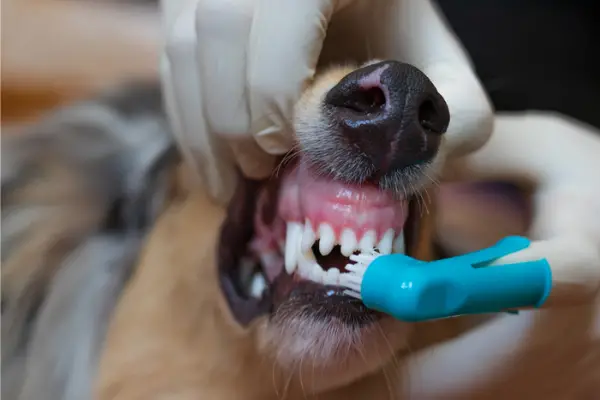
There’s more to keeping your dog healthy than food, hygiene, and shelter. Most pet owners think that giving vitamins, food supplements, and grooming are all that it takes to keep your dog healthy. Many people forget that your dog's dental health & oral hygiene is just as important. In this article, we will explore the following dog teeth cleaning tips:
- How to clean your dog's teeth with brushes
- Using wipes for a thorough dental cleaning
- Keeping your dog's teeth clean with wipes
- Obtaining healthy teeth with dog dental treats & dog chews
- Preventing dental problems with dog chew toys
- Professional dental cleanings for dogs' teeth
At the age of three, about 60% of dogs start showing signs of periodontal disease. It begins with bad breath and proceeds to other signs. Indeed, most dogs don’t have fresh breath since they don’t regularly brush anyway, but when the smell becomes noticeably bad, then something is wrong.
Gum disease is as common in dogs just as it is in humans. If ignored and untreated, it can lead to severe health problems and even death. The lack of treatment leads to tooth loss, which corresponds to abscess and infection. You don’t want that to happen because the bacteria in most types of dental disease could travel to the pup’s organs, i.e., heart and kidneys, and will eventually cause death.
Fortunately, gum disease in dogs is something that you can prevent by embracing the responsibility of teeth cleaning.
If you’re interested in practicing good oral hygiene for your four-legged buddy, read on.
Related article: Best Way To Clean Dog’s Teeth, Insider Pro Tips
6 Dog Teeth Cleaning Tips
1) Brushing To Prevent Dental Disease
Only one out of ten dog owners are successful in brushing their dog’s teeth. Veterinarians recommend it, but doing it regularly is easier said than done.
Dogs don’t like being forced to open their mouth and have their teeth messed with, so it’s hard to blame owners for skipping it. Nonetheless, regular teeth brushing for your dog’s teeth is an effective way of preventing the buildup of plaque which may lead to periodontal disease and other dental problems.
If you’re worried that your pup might not like it, keep in mind that you don’t have to clean your dog's teeth daily. The rule of thumb is to do it as often as possible.
You need two things to brush your dog’s teeth: a dog toothbrush and dog toothpaste.
WARNING: Don't use toothpaste meant for humans as it may contain Xylitol, Fluoride, SLS, and other toxic ingredients to dogs.
An interesting fact about dog toothpaste is that they’re flavored with tasty ingredients dogs love, i.e., peanut butter or chicken. As for the dog toothbrush, you can go for a finger toothbrush or a traditional one.
By using things that are specifically made for dogs, you’re ensuring your dog’s safety and, of course, effective teeth and mouth cleaning.
2) Wipes To Help Minimize Dental Disease
If brushing your dog’s teeth is a seemingly impossible task, an excellent alternative is using dental wipes to improve your dog's dental health without the trauma of a brush.
Dog dental wipes are helpful and convenient in wiping away food debris and residues right after a meal.
Simply rub the wipes against your dog's teeth to prevent dental problems such as plaque buildup, bad breath, tooth decay, etc. It may not be able to get into tiny nooks and crannies of the teeth as the brush, but it’s handy when your goal is to clean your dog’s teeth every day.
For example, you can brush your dog’s teeth once a week and then use dental wipes on the other days. This way, your dog’s teeth are regularly cleaned, and food buildup will not be just as much as when you don’t brush them.
You can also use the wipes with a small amount of dog-specific toothpaste, so they become more interested in it.
The key is consistency! Regular teeth cleaning will seriously minimize your dog's risk of periodontal disease and other dental problems.
And, as you do this more often, your dog will not fight you.
3) Dog Dental Treats
The best thing about dog dental treats for keeping your dog’s teeth clean is that your dog will love them!
These dog treats are called a dental “treat” because while it removes plaque and food debris, they are also delicious and edible.
In other words, you won’t have to do anything to convince your pup to eat a tasty treat. With different flavors, sizes, shapes, and colors, these dog treats are a fun and highly effective way of keeping the dog's mouth clean and your dog's breath refreshing.
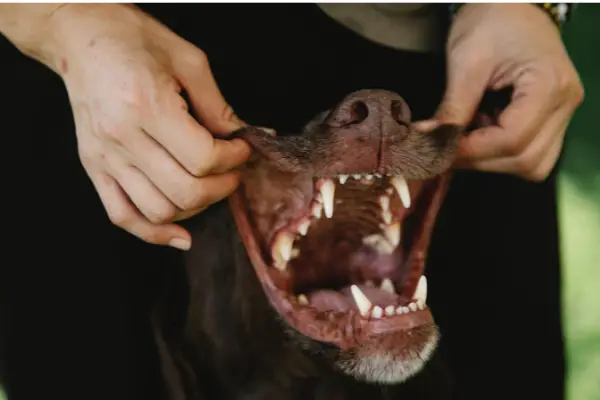
4) Dog Chews For Healthy Teeth
Dog chews are like dog dental treats.
The only difference is that they offer a challenge and take your dog a while to consume. While dental treats are primarily made to keep the product as delicious as possible, dog chews focus on maximizing teeth' cleaning properties.
Dog chews are made from an extensive array of materials, from cow ears and chicken strips to bully sticks and rawhide. This helps encourage gnawing, which corresponds to effectively scraping off plaque from your dog's teeth. Since these products come with enzymes that promote dental health, you’re guaranteed that the constant chewing habit that your dog develops with it will make sense.
Many dog owners prefer chews instead of dental treats because dog chews have fewer calories. Some varieties don’t even have any nutritional value in them other than the enzymes that help eliminate plaque.
5) Dog Chew Toys For Clean Your Dog's Teeth
Dogs love playtime more than teeth brushing. The following dog teeth cleaning tip will be a great way to keep your dog’s mouth clean.
As a matter of fact, they don’t even care about dental hygiene. As the owner, it’s up to you to protect them from possible dental problems. And most of the time, you can only resort to using one of the things they love - playing.
Dog chew toys are made precisely to help keep dogs’ teeth healthy and clean while they are having fun.
Now, not every chew toy is made specifically for oral hygiene. So it’s best to go for the toys made exactly for that. This way, you’re not only buying a toy to keep your dog occupied, but you’re also keeping them healthy.
Check out our article featuring some of the Best Dog Teeth Cleaning Toys to find some great toys that will help keep your dog's teeth clean.
Do Dog Teeth Cleaning Toys Work?
For a simple answer: Yes, dog teeth cleaning toys work.
Chewing is often not accepted in the household, especially if your dog loves chewing on your shoes and furniture. However, if you give your dog the right thing to chew on, like dog teeth cleaning toys, the benefits are enormous.
Chew toys promote dental health in several ways:
- Chewing a dog toy or treat naturally breaks up the plaque on your dog's teeth.
- Chewing helps smoothen the dog’s teeth and scrape away tartar.
- It helps promote antibacterial saliva, which helps clean the dog’s mouth.
- It can improve your dog’s breath.
For these reasons, it’s easy to see that dog teeth cleaning toys work in fighting dental and periodontal diseases. However, you should also know that chew toys should never be a replacement for dog toothbrushes.
You can use these toys as supplements for brushing. After all, if your dog loves to play, you might as well take advantage of playtime as also a time for them to clean their teeth. But it’s still crucial that you, a dog owner, brush your dog’s teeth, even if it’s just once a week.
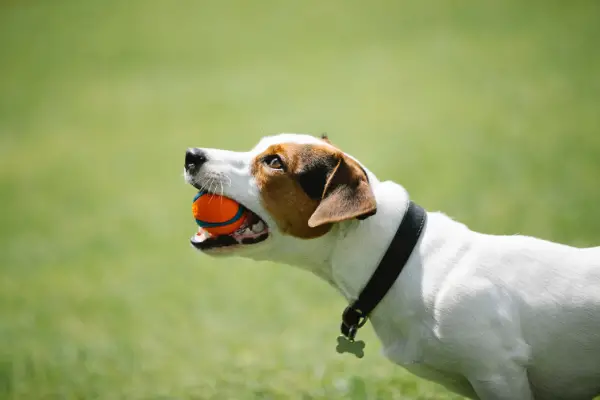
Choosing The Right Chew Toy For Your Dog
Chew toys are one of the best toys to give to your dog - they’re entertaining, fun, and offer many benefits, especially when it comes to maintaining or improving their dental health.
It’s essential that you order the right kind that will not put your dog under any harm.
If you search online for “chew toy”, you’ll get many results. There are so many different kinds such as:
- Rubber chew toys
- Rope toys
- Plush chew toys
Here are some dog teeth cleaning tips that will help you find a suitable chew toy for your dog:
- The size: When choosing a toy, make sure you consider your dog’s size or the size of your dog’s mouth in particular. If your dog chews a toy that’s too small, it becomes a choking hazard.
- Materials: Next, you’d want to look at the materials used to make the toy. The last thing you want is to endanger your dog because you’ve bought a toy made of toxic or harmful materials.
- Durability: Dogs can be destructive, and the last thing you’d want is to waste your money on something that wouldn’t last forever. Make sure that you check the toy and see if it’s durable enough and can survive your dog’s activity.
- Level of hardness: While you’re looking for a durable toy, you wouldn’t want it to be too hard for your dog. On the other hand, dog toys that are too soft are also not good. If the toy is too soft, it might not already serve its purpose, and your dog might just tear it fast.
- Ease of washing: As the name implies, chew toys are toys your dog chews on, and you definitely want to keep that clean. So make sure that you buy a toy that’s easy to wash.
Another thing we would consider is how the toy looks or the features it has.
Dogs can be easily attached to things, and first impressions are important. That’s why it’s vital that you buy a toy your dog would actually like. One that has extra features is great as it adds a little bit more fun for your dog.
Related article: Hartz Chew n Clean Bacon Flavored Dog Chew Toy, Our (2022) Review
6) Professional Dental Cleanings
Finally, you can take your dog to a vet for a professional dog dental cleaning.
There's no denying that keeping your dog's teeth clean at home involves a lot of brushing. However, if you're already having a hard time with it, then it's not bath to finally seek help from an expert.
Veterinarians are qualified and trained to clean dogs' teeth using various methods that you certainly can trust.
The professional dog dental cleaning solution depends on the dog’s specific needs, health issues, and attitude. Some methods are more expensive than others, but it’s always best to get your dog treated by an expert.
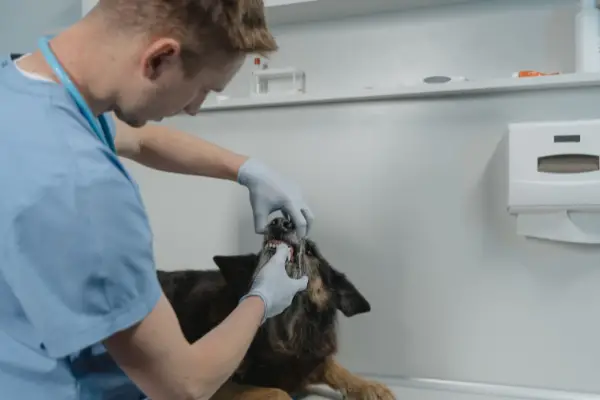
Annual Dental Cleaning
Your dog’s dental health is as important as yours. That’s why it’s highly recommended that your dog gets its teeth cleaned at least once a year. However, this could also vary depending on your dog’s breed, age, and lifestyle.
- Age: Vets would highly recommend taking your adult dogs to the dentist at least once a year and your younger pups for more frequent cleanings. Younger dogs have shallow roots, which are more susceptible to dental problems, and it’s wise to invest in more dental checkups.
- Size: Like with age, small dogs or breeds would require more frequent dental visits than larger breeds. The main reason is that the teeth of smaller dogs are larger relative to their mouths, which causes overcrowding, especially if they hang on to their baby teeth.
A dental check-up would allow for regular monitoring of the inside of your dog’s mouth, which can help prevent plaque and tartar buildup caused by overcrowding. - Breed: The next thing we have to consider is the dog breed. Dog breeds like Pugs, Bulldogs and Shih Tzus all have short faces and noses, making them more at risk for dental problems. The shape of their mouths makes their teeth easily deformed, allowing more places for tartar to hide. Another breed-related dental disease found in dogs is called malocclusion, a deformation where the dogs’ jaws are misaligned. Because of this, tartar can quickly build up, leading to more teeth damage.
- Lifestyle: Last but not least is your dog’s lifestyle at home. If your dog has a good dental routine, professional cleanings may not be as needed as frequently.
Usually, the vet will have to thoroughly check your dog’s mouth to find any signs of dental problems before the actual teeth cleaning. This includes:
- Loose or broken teeth
- Extra teeth or baby teeth that have been retained
- Discolored teeth
- Bad breath
- Swelling, pain, or bleeding
- Plaque
In other words, they’ll check the severity of your dog’s dental disease, clean their teeth, and provide advice on what you can do to maintain your dog’s teeth and when you can bring them back for another cleaning.
Remember, having regular dental cleanings is not enough. It’s always essential to keep your dog’s teeth healthy at home.
An Unusual Professional Dental Cleaning Option
One option is to consider having a professional dental cleaning performed while your dog is undergoing surgery for another issue. Unfortunately, Bailey (my Chocolate Lab) had to get a growth removed. While she was under anesthesia, our vet was able to complete an extensive professional dental cleaning.
While this is a rare situation for us, it was nice to get a very comprehensive professional dental cleaning performed!
One thing to note here...
As a personal testimony that the above dog teeth cleaning tips work, I only had a professional dental cleaning done twice for Bailey’s teeth. And I attribute this to being diligent in utilizing other dog dental cleaning methods as outlined in this article.
What to Expect in Professional Teeth Cleaning?
If you haven’t taken your dog to get their teeth professionally cleaned before, here are some things you can expect.
The first thing you should know is that your dog will have to be put under general anesthesia. There are three reasons for this:
- To minimize your dog's stress once the cleaning starts.
- A breathing tube needs to be placed down your dog's trachea to help him breathe during the cleaning process.
- Some dogs may have more plaque and tartar buildup, requiring more specialized tools.
To ensure your dog's safety, the vet would need to run some blood tests to know if your dog is healthy enough to handle the anesthesia. Aside from that, dental x-rays must also be done to help evaluate your dog's overall dental health. The x-rays allow them to have a closer look at every tooth and perform a tooth-by-tooth exam.
During the procedure, the vet will check your dog's oral health. They will check for cavities, the existence of non-vital dog teeth, gum disease, and probably other deformities. While you might have only gone to the vet for a routine dental cleaning, the vet might need to do extra steps like extracting a tooth if required.
The vet will also continuously monitor your dog's vital signs throughout the procedure to ensure that they are safe.
What happens after the dental cleaning?
Generally, a second x-ray is taken to ensure that your dog's mouth is healthy and no problems would arise by the time your dog wakes up.
You should also know that your dog will have to stay in the clinic until it recovers from anesthesia. And in cases where teeth extractions were done, your dog might even need to take painkillers to minimize their pain and discomfort.
Aftercare is critical in every professional dental cleaning procedure. So remember to follow your veterinarians' recommendations, particularly the diet to give your dog while his mouth still heals, the kind of activities your dog can do in the meantime, and how long your dog needs to heal.
When Can You Take Your Dog for a Professional Dental Cleaning?
If you want the help of a vet to keep your dog's teeth clean, there's one thing you should know: Your dog should be fully grown and healthy enough to handle the anesthesia.
For most dogs, that age would most likely be when they're already two years old. But then again, it's a case-to-case basis. So, while you can’t take your dog for a professional dental cleaning yet, you need to make sure they're receiving proper dental care at home.
Related article: How to Brush Dog’s Teeth, A Comprehensive Guide
At-Home Cleaning Tips To Keep Your Dog's Teeth Clean
It's easier said than done to clean your dog's teeth. We can give you several means on how to do that, such as the things we enumerated above, but the truth is, cleaning your dog's teeth can be difficult.
That's why we compiled several dog tooth cleaning tips that will help make this daunting task easier.
Start When Your Dog Is Young
Dogs are like kids. Anything new to them can be scary, including teeth brushing. That's why it's very helpful if you can begin brushing your dog's teeth while they're still pups.
That's the only way you can develop an effective dental care routine that they'll get used to until they turn into adult dogs.
Developing a Regular Dental Cleaning Routine
Starting your dog early won't magically make them get used to teeth brushing if you're not consistent.
While the goal is to be able to brush your dog’s teeth once a day, you can start by brushing your dog's teeth at least 2-3 times a week. Your dog will probably spend the first week trying to fight you, but keep going.
Find a way to get your dog to trust you, probably by starting to introduce the tools you're going to use slowly.
The next tips we're going to give you will be very helpful in making this happen...
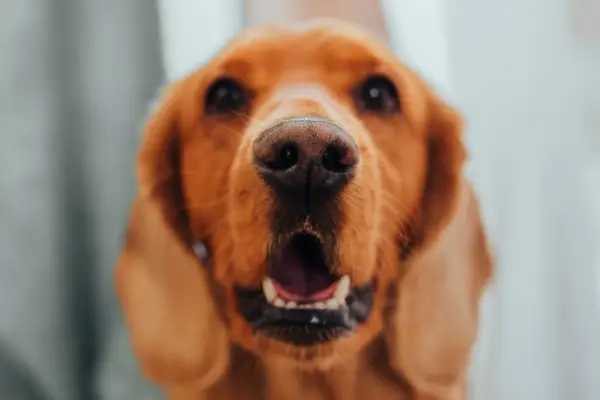
Step 1) Find The Right Time
You can't just go at your dog carrying a dog toothpaste and toothbrush and then expect them to be okay with that. There's a big chance they will go run away.
So, find the right time.
It's best to approach dogs when they're calm and relaxed. You can start with once a week, building up to 2-3 times a week, until it gets to a point you can already brush your dog's teeth once a day.
Step 2) Use The Right Tools
Brushing your dog's teeth requires proper tools - a toothbrush and a toothpaste - but the ones made for dogs.
Unlike our toothbrushes, dog toothbrushes have softer bristles and are specially angled. This ensures your dog's safety, and it's also easier to remove food buildup on your dog's mouth as it specifically reaches areas in the gum line that ordinary brushes can't reach.
The same with toothbrushes, you should use dog-specific toothpaste, too. As we already mentioned above, human toothpaste contains ingredients toxic to dogs. Dog toothpaste, on the other hand, is guaranteed safe and even comes in a flavor that dogs will love.
Step 3) Position Yourself Right
Think about your dog's feelings.
Your dog is scared, and the last thing they need is you standing over him. Instead of doing this while standing, make sure to kneel or sit in front or side by side with your dog, allowing yourself to be at their eye level. You want to make your dog feel equal to you so he will trust you.
Step 4) Touch Your Dog's Gums
Set your dog's expectations by making them recognize how it feels when their teeth are being brushed.
Once your dog is comfortable with you, test their willingness by opening their mouth and touching their gum line. Run your fingers along their gums and teeth, so your dog knows how it feels to have something against their teeth.
Do this every time before you start brushing until your dog is no longer scared.
Step 5) Start With A Few Teeth At A Time
You don't have to brush all of your dog's teeth in one go. Since we're starting them young, it's best to start with a few teeth in a day and increase the number day by day. Brush your dog's teeth at least for 2 minutes max at first or until your dog starts to resist.
First, go for the outsides and the back of your dog's teeth. This way, it's possible to finish cleaning all of your dog's teeth before they start complaining. Once your dog becomes more comfortable, you can soon clean in between dog teeth.
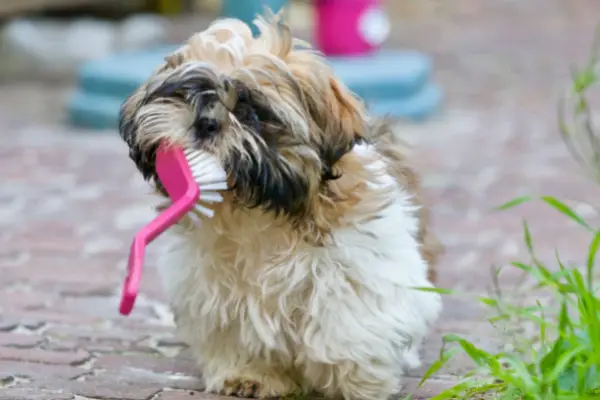
Use Delicious Toothpaste
Make your dog love getting their teeth cleaned by using a dog toothpaste they will love.
Dog-specific toothpaste usually comes in many flavors like peanut butter, beef, and chicken. And since you're the dog owner, surely, you would know what flavor your dog will love, right? If you don't have an idea, you can experiment with flavors, possibly mixing some of them to create a taste your dog wouldn't be able to resist.
Before brushing your dog's teeth, you can let them taste the toothpaste first to see if it's their liking. Simply put some dog toothpaste on the tip of your finger and allow your dog to lick it.
Try The Toothbrush
Like dog toothpaste, you want to make sure that your dog is comfortable with the brush bristles.
Start by lifting your dog's upper lip and brushing a small portion at first. Start slow, making sure that your dog is comfortable before you go all out. Angle the brush at 45 degrees to reach your dog's gum line while cleaning up the plaque buildup.
Feed a Dental Diet
What's your dog's food? If you're frequently feeding your dog soft food, then maybe it's time to switch to dental care dry foods as your dog's everyday meals.
Wet or soft food is more likely to stick to a dog's teeth, contributing to food buildup, plaque, and soon decay. Dry food, on the other hand, is specifically shaped and textured to help scrub your dog's teeth, which prevents plaque.
Supplement with Dental Treats, Dental Chews, and Chew Toys
If you can't brush your dog's teeth daily, or if you're still having a hard time building that routine, it's wise to supplement with dental treats, dental chews, and toys.
What's good about supplementing is that even if you don’t brush or clean your dog's teeth daily, food buildup wouldn't be as nasty as when you won't supplement. The best part, they help prevent periodontal disease and other dental problems in a delicious and fun way.
On top of that, your dog won't even know you're targeting the plaque in their mouth.
However, be reminded that these should only be supplements and must never replace teeth brushing.
Alternate Between a Brush and A Gauge
If you don't want your dog to be too scared of a toothbrush, you can always alternate between using a brush and a gauge.
Simply wrap your finger with a gauge, place dog toothpaste at the tip, and rub your dog's teeth clean. Simply make small, circular motions, and don't hesitate to lift your dog's lip to reach the tooth area that touches your dog's cheek. Tartar is mainly concentrated in these hidden areas, so make sure you reach there.
By alternating a toothbrush and a gauge, you help your dog get a bit of rest from the toothbrush.
If you don't have a gauge, you can use dental wipes to clean your dog's teeth and minimize food buildup.
Praise Your Dog For Doing A Good Job
Most dogs love to be praised, and if your dog behaves well while you clean their teeth, you'd want to commend them after brushing their teeth clean.
Praise your dog for being well-behaved as this will help encourage them to participate in regular teeth brushing. Oh! Don't forget the dog treats to keep your dogs happy while maintaining excellent oral hygiene.
Dog's Dental Health FAQs
How can I get plaque off my dog's teeth?
Plaque is a sticky film of bacteria formed as a result of food and saliva buildup in your dog's mouth. If not treated, it can lead to serious dental problems like painful gum disease, infections, and tooth loss.
There are four foolproof ways to remove plaque from your dog's teeth:
- Brushing: Brush your dog's teeth using a dog toothbrush and dog-specific toothpaste to ensure their safety and comfort.
- Chewing: While chewing is a dog behavior that is considered to be negative, it's helpful for dogs as long as they chew the right things. We're talking about dental treats and chew toys that are fun and helpful in cleaning dog teeth.
- Switching from wet food to dry food: Soft foods stick to the teeth faster than dry food, contributing to the buildup.
- Professional Dental Cleanings: While the three above help a lot in removing plaque, the most surefire way to remove all of them is by getting your dog's teeth cleaned by a dentist at least once a year.
How can I remove tartar from my dog's teeth naturally?
When plaque isn't removed from your dog's teeth, it can harden and turn into tartar, making it more difficult to remove.
Of course, removing tartar may require the same things mentioned above:
- Brushing
- Chewing dental treats, dog chews, and chew toys
- Dental Cleaning
- Switching from wet to dry food
However, some natural cleansers might help you:
The first thing you can try is coconut oil. It contains acids that can help kill fungus and bacteria in your dog's mouth. Dogs can consume it safely, and they seem to really like the flavor. You can alternate it with dog toothpaste at any time or use it as a supplement to help clean your dog's teeth.
Aside from coconut oil, you can also try other herbal extracts and essential oils. There are dental sprays and gels available in the market that usually contain natural extracts such as:
- Grape seed extract
- Thyme oil
- Peppermint oil
- Grapefruit seed extract
When formulated properly (and safely), these ingredients are very effective in dissolving tartar. They are also great for when you want to prevent tartar and probably heal your dog's gums.
Another thing you can use to remove tartar from your dog’s teeth naturally is raw bones.
Raw bones are very effective and function like dog treats. However, it must be given moderately to dogs because the hardness of these bones can cause significant damage to your dog’s teeth.
WARNING: Never use baking soda to clean your dog's teeth.
Baking soda is very abrasive, making it effective in removing the tartar. A lot of people recommend it, but vets will tell you otherwise. Baking soda has a very high alkaline content, disrupting your dog's acid balance once ingested. And while it may not be fatal, it's uncomfortable.
At the same time, dogs dislike the taste of baking soda, which will cause them to complain and move around during tooth brushing.
Let's stick to the safer alternatives instead of going for this route.
Can you scrape plaque off the dog's teeth?
No, you can't scrape plaque off your dog's teeth on your own. If not done right, you can damage the dog teeth enamel, which can lead to more complications such as:
- Being more susceptible to tooth decay
- Gum bleeding
- Pain and sensitivity
If you want the plaque to be scraped off your dog's teeth, go to a reputable and qualified vet. You should also know that in professional dental cleanings, vets do this procedure when needed.
How can I deep clean my dog's teeth at home?
Deep cleaning a dog's teeth at home is a challenge. Ideally, you need to brush your dog's teeth every day. However, because it's very challenging, dog teeth brushing is better done a few times a week than none at all.
Here are some tips that might help you clean your dog's teeth at home without any problems:
- Begin brushing your dog's teeth only when he's calm and relaxed.
- Introduce the tools first. Let your dog taste the toothpaste to know if it's the flavor he likes, and let him test the toothbrush.
- Place your finger on your dog's teeth and start rubbing it in a circular motion. This is a great way to prepare him for the actual tooth brushing.
- You can start using your finger to brush your dog's teeth. All you need to do is wrap it in a gauge, put a toothpaste, and brush as if you're using a real toothbrush.
- Start slowly, and don't force your dog when he's uncomfortable. Begin brushing the dog teeth surface and moving up to the gums. Make sure that you don't miss the teeth behind your dog's cheek, as build-up usually gathers there.
- Supplement with dental treats and teeth cleaning toys to help remove plaque that brushing couldn’t get rid of.
Do these consistently until you can get your dog to enjoy getting his teeth brushed.
Final Words For Your Dog's Dental Health
It's not only us who need to maintain good dental hygiene; your dogs need it, too.
- Bad breath
- Plaque and tartar
- Tooth decay
- Bleeding gums
- Painful infections
These are only a few of the many dental problems dogs can get if you don't pay attention to their teeth. And these are only the start. If not prevented, the infection can spread to your dog's body, leading to even more serious problems like kidney disease and even death.
Brushing your dog's teeth is undeniably challenging. That's why it's no surprise that most pet owners tend to skip it. But you have to remember that when you do, your dog is the one who suffers from it.
Use the guide we have above to help you build an effective cleaning routine for your fur baby.
https://www.furryfriendsgear.com/dog-teeth-cleaning-tips/?feed_id=91&_unique_id=62a0ed94aa609Dog Teeth Cleaning Tips posted first on https://furryfriendsgear.blogspot.com
No comments:
Post a Comment